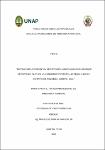| dc.contributor.advisor | Burga Alvarado, Ronald | |
| dc.contributor.author | Perez Serrano, Sergio Marti | |
| dc.date.accessioned | 2022-11-22T18:02:22Z | |
| dc.date.available | 2022-11-22T18:02:22Z | |
| dc.date.issued | 2022 | |
| dc.identifier.uri | https://hdl.handle.net/20.500.12737/8557 | |
| dc.description.abstract | The horizontal structure of commercial species of the high-terrace forest of forestry concession 16-REQ/C-J-190-04, district of Requena, Loreto, was determined. Data from the forest census of commercial species of PC1 for lumber purposes were evaluated. A total of 2,646 trees were registered, grouped into 32 commercial forest species and 13 botanical families. The Fabacea family contains the highest number of species (10 species). The distribution of the number of trees by diameter class is 1,53 trees/ha (2646 trees), where Cedrelinga cateniformis (0,29 trees/ha, 503 trees), Allantoma decandra (0,26 trees/ha, 372 trees), Parkia nitida (0.16 trees/ha, 272 trees), O. arborea (0,10 trees/ha, 179 trees) and Brosimum. rubescens (0,08 trees, 145 trees) show the highest number of trees. Cedrelinga cateniformis (Fabaceae) is the most ecologically important species with an IVI of 5125%, followed by Allantoma decandra (33,69%), Parkia nitida (23,35%), Ormosia arborea (15,87%) and Aniba panurensis (13,56%) The results show a highly significant difference between the averages of the horizontal structure between species. | en_US |
| dc.description.abstract | Se determinó la estructura horizontal de especies comerciales del bosque de terraza alta de la concesión forestal 16-REQ/C-J-190-04, distrito de Requena, Loreto. Se evaluaron los datos del censo forestal de las especies comerciales de la PC1 con fines maderables. Se registraron un total de 2646 árboles, agrupados en 32 especies forestales comerciales y 13 familias botánicas. La familia Fabacea contiene el mayor número de especies (10 especies). La distribución del número de árboles por clase diamétrica es de 1,53 árboles/ha (2646 árboles), donde Cedrelinga cateniformis (0,29 árboles/ha, 503 árboles), Allantoma decandra (0,26 árboles/ha, 372 árboles), Parkia nítida (0,16 árboles/ha, 272 árboles), Ormosia arbórea (0,10 árboles/ha, 179 árboles) y Brosimum rubescens (0,08 árboles, 145 árboles) muestran el mayor número de árboles. Cedrelinga cateniformis, de la familia Fabaceae, es la especie ecológicamente más importante con un IVI de 51,25%, seguida de Allantoma decandra (33,69%), Parkia nitida (23,35%), Ormosia arborea (15,87%) y Aniba panurensis (13,56%). Los resultados indican que existe diferencia altamente significativa entre los promedios de la estructura horizontal entre especies. | es_PE |
| dc.format | application/pdf | es_PE |
| dc.language.iso | spa | es_PE |
| dc.publisher | Universidad Nacional de la Amazonía Peruana | es_PE |
| dc.rights | info:eu-repo/semantics/openAccess | * |
| dc.rights.uri | https://creativecommons.org/licenses/by/4.0/ | * |
| dc.subject | Estructura del bosque | es_PE |
| dc.subject | Árboles maderables | es_PE |
| dc.subject | Especies | es_PE |
| dc.subject | Suelo de altura | es_PE |
| dc.title | Estructura horizontal de especies comerciales del bosque de terraza alta de la concesión forestal 16-REQ/C-J-190-04, distrito de Requena, Loreto. 2021 | es_PE |
| dc.type | info:eu-repo/semantics/bachelorThesis | es_PE |
| thesis.degree.discipline | Ingeniería Forestal | es_PE |
| thesis.degree.grantor | Universidad Nacional de la Amazonía Peruana. Facultad de Ciencias Forestales | es_PE |
| thesis.degree.name | Ingeniero(a) Forestal | es_PE |
| dc.subject.ocde | https://purl.org/pe-repo/ocde/ford#4.01.02 | es_PE |
| renati.author.dni | 61266967 | |
| renati.advisor.orcid | https://orcid.org/0000-0003-1947-3206 | |
| renati.advisor.dni | 01035999 | |
| renati.type | https://purl.org/pe-repo/renati/type#tesis | es_PE |
| renati.discipline | 821046 | es_PE |
| renati.level | https://purl.org/pe-repo/renati/level#tituloProfesional | es_PE |
| renati.juror | Alván Ruiz, Jorge Elias | |
| renati.juror | Maury Laura, Angel Eduardo | |
| renati.juror | Bardales Meléndez, Juan de la Cruz | |
| dc.publisher.country | PE | es_PE |


